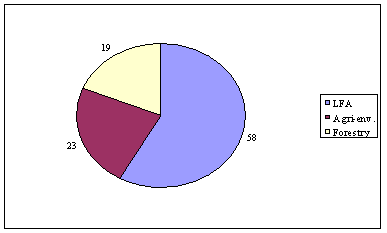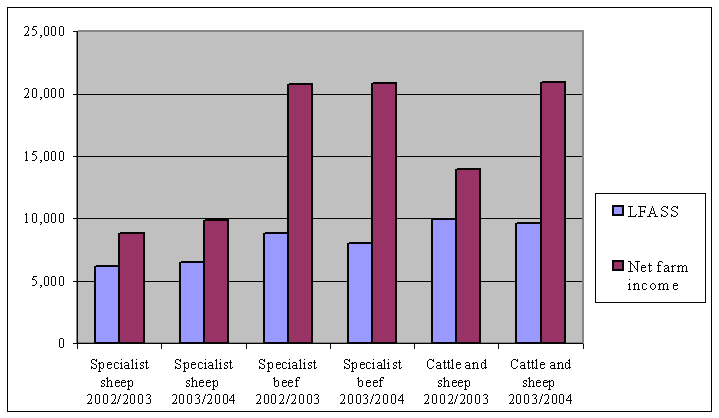
THE STATE OF SCOTLAND'S FARMED ENVIRONMENT 2005
20. The Less Favoured Areas Support Scheme
Uptake
The total amount spent on LFASS remains rather constant at about £60 million from 2001 to 2006. The Scottish Executive (2005a) predicted a yearly coverage of about 2 million ha and about 11,500 beneficiaries per year within the scheme. However, Table 20.3 shows that the uptake of LFASS in 2004 was about 12 percent more than anticipated by SEERAD, which could mean that the area covered by the scheme was slightly higher, too.
Table 20.3 : Total LFASS recipients and payments by Scottish sub-regions (NUTS 3) for scheme year 2004
| Recipients | Payments (£’000) | Average payment (£/recipients) | |
|---|---|---|---|
Aberdeen City , Aberdeenshire & North East Moray |
1,234 |
5,069 |
4,108 |
Angus & Dundee City |
135 |
1,075 |
7,963 |
Clackmannanshire & Fife |
125 |
592 |
4,736 |
East & Midlothian |
90 |
827 |
9,189 |
Borders |
636 |
6,220 |
9,780 |
City of Edinburgh |
- |
- |
- |
Falkirk |
78 |
212 |
2,718 |
Perth & Kinross and Sterling |
613 |
4,796 |
7,824 |
West Lothian |
68 |
348 |
5,117 |
East and West Dunbartonshire & Helensburgh & Lomond |
100 |
714 |
7,140 |
Dumfries & Galloway |
1,255 |
9,634 |
7,676 |
East & North Ayrshire and Mainland |
397 |
1,811 |
4,562 |
Glasgow City |
- |
- |
- |
Inverclyde, East Renfrewshire & Renfrewshire |
139 |
644 |
4,633 |
North Lanarkshire |
93 |
309 |
3,322 |
South Ayrshire |
211 |
1,524 |
7,223 |
South Lanarkshire |
461 |
2,448 |
5,310 |
Caithness & Sunderland, Ross and Cromarty |
1,578 |
5,321 |
3,372 |
Inverness & Nairn, Moray, Badenoch & Strahspey |
518 |
3,429 |
6,620 |
Lochaber, Skye & Lochalsh and Argyll & the Islands |
1,706 |
8,421 |
4,936 |
Western Isles |
1,760 |
1,514 |
860 |
Orkney Islands |
711 |
3,129 |
4,400 |
Shetland Islands |
1,014 |
2,038 |
2,010 |
Scotland Total |
12,931 |
60,212 |
4,656 |
Source: SEERAD (2005b)
Impact
Expenditure in the Scottish Rural Development Plan is dominated by LFA support (Figure 20.1). 58 % of its spending is allocated to LFA support following figures published by SEERAD (2005a) in the latest amendments of the SRDP. It is primarily targeted at the objective to assist the viability and sustainability of Scottish farming, with particular reference in to remote and peripheral regions. The LFASS has been reviewed several times and has grown in complexity over the years, especially recently, as SEERAD has tried to reconcile farm income stabilisation with general environmental concerns enforced by CAP reform.
Figure 20.1 : Public expenditure allocation in the Scottish Rural Development Plan 2000-2006 (in percent) (computed from SEERAD, 2005a) *
 * Figure 20.1 includes funding from national modulation but excludes funding from EU modulation which will be used to finance the LMC Menu Scheme.
* Figure 20.1 includes funding from national modulation but excludes funding from EU modulation which will be used to finance the LMC Menu Scheme.
Farm Account Survey data for LFA farm types show that LFASS contributed significantly to the income of LFA farms. Figure 20.2 compares net farm income and LFASS receipts of LFA farm types (specialist sheep, specialist cattle and cattle and sheep)
Figure 20.2 : Net farm income and LFASS receipts of LFA farm types (in £) in 2002/2003 and 2003/2004 (computed from SEERAD, 2005c).

In 2002/2003 and 2003/2004 LFASS receipts of specialist sheep farms are around 70 percent and 65 percent of the net farm income, while for specialist cattle farms the share of LFASS at the net farm income is significant lower, although it still contributes 43 percent and 38 percent of the net farm income, in these two years. Because of low output in 2002/2003 compared to the following year net farm income of cattle and sheep farms is significant lower in this year. However, in both years LFASS receipts provide an important contribution to income of cattle and sheep farms.
While the positive income effect for LFA farms is widely recognized, the scheme has been criticized, in particular in the early years, for focusing on the importance of LFA payments to farming incomes, and not on environmental or wider-economy issues (DTZ Pieda, 2003). It is often see as a “hidden” subsidy for sheep farmers lacking demanding changes to the scheme to deliver more environmental benefits. Moreover, the relevant target for the LFASS as set by the Scottish Executive to sustain agricultural activities in Scotland ’s remote hills has been subject to criticism as many farm businesses receiving LFASS are not in remote hill areas (see Table 20.3 for number of recipients). A number of changes have been implemented in the scheme responding to the criticism and changing EU frameworks. Minimum and maximum stocking densities have been implemented to avoid overcompensation and reduce the risk of overgrazing, in particular since the introduction of the lower maximum stocking density of 1.4 in 2004. In the same year new environmental controls have been added and Good Farming Practice guidelines with respect to overgrazing have been expanded (SEERAD, 2005a). However, the need has been expressed during an evaluation of the SRDP to strengthen and clarify the guidelines, creating a unified Code of Practice for the agricultural industry with the Good Farming Practice being a part of that (Ward and Thompson, 2002). Moreover, adjustments to the scheme towards supporting cattle grazing have been made to account for anticipated implications of the recent CAP reform such as reduction of cattle numbers in marginal areas.
There has been no integration with nature quality schemes or designations such as Sites of Special Scientific Interest (SSSIs) identified by environmental agencies or Environmentally Sensitive Areas (ESAs) implemented under Regulation 2078/1992 (Thomson, 2004). However, while environmental aspects are included in the aim of the scheme, it remains mainly a socio-economic support instrument for farming in disadvantaged areas. During the negotiations on the new RDR, to be implemented in 2007, discussions have taken place on how to revise the European LFA designation, which would potentially lead to changes in the design of LFASS or any other future specific LFA payment, but a decision on such revisions has been postponed until 2010 (Agra Europe, 2005). However, SEERAD will be including proposals for an interim LFASS scheme for 2007-2010 in its upcoming consultation on the Scottish Rural Development Plan.
Sources
- Agra Europe (2005): Rural development rules set post-2007. Agra Europe , No 2162, 24.06.2005, EP9 – EP11.
- DTZ Pieda Consulting (2003): Baseline Study for the Scottish Rural Development Programme. Report for SEERAD.
- ESPON (2004): Espon Project 2.1.3: Territorial impact of CAP and Rural Development Policy . Arkleton Institute for Rural Development Research. Espon, Luxemburg.
- SEERAD (2004): The Less Favoured Area Support Scheme (LFASS) 2005. External Website
- SEERAD (2005a): Rural Development Regulation (EC) No 1257/1999: Rural Development Plan for Scotland (Amended February 2005) External Website
- SEERAD (2005b): The Administration of Common Agricultural Policy Schemes in Scotland Annual Report 2004. External Website
- SEERAD (2005c): Economic Report on Scottish Agriculture: 2005 Edition. External Website
- Thomson, K . (2004): The Less Favoured Area Scheme in Scotland . ESPON Project 2.1.3: The Territorial Impact of CAP and Rural Development Policy. Accessed at: External Website
- Ward, N . and Thompson, N. (2002): The Implementation of the EU Rural Development Regulation in Scotland , Research Report to the World-Wide Fund for Nature, Scotland .
Environmentally Sensitive Area Scheme and Countryside Premium Scheme >>


